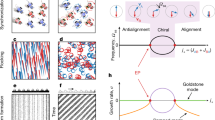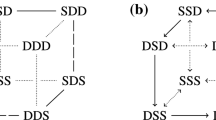Abstract
Under conditions in which absolute phase and frequency synchronization are neither essential nor attainable for biological functioning, some form of relative coordination is still possible. Attraction toward certain phase and frequency relations remains, but phase slippage as well as occasional skips and jumps occur as the component units adjust spatially and temporally. We establish the connection between this less rigid form of coordination and intermittency, a generic feature of dynamical systems near tangent bifurcations. Intermittency provides a mechanism for entering and exiting mode-locked states, endowing the system with a vital mix of flexibility and coherence. In the intermittent régime close to critical points, the system possesses a ‘predictive’ or ‘anticipatory’ property. The identified dynamics are level-independent and may be essential to a number of different biological functions.
Access this chapter
Tax calculation will be finalised at checkout
Purchases are for personal use only
Preview
Unable to display preview. Download preview PDF.
Similar content being viewed by others
References
Haken, H. (1977/1983). Synergetics, an introduction: Non-equilibrium phase transitions and self-organization in physics, chemistry and biology. Berlin: Springer-Verlag, 3rd edition.
Kelso, J.A.S. (1981). On the oscillatory basis of movement. Bulletin of the Psychonomic Society,18, 63.
Kelso, J.A.S. (1984). Phase transitions and critical behavior in human bimanual coordination. American Journal of Physiology: Regulatory, Integrative and Comparative Physiology, 15, R1000-R10004.
Cohen, A.V., S. Rossignol, & S. Grfflner (Eds.) (1988), Neural control of rhythmic movements in vertebrates. New York: John Wiley.
Kopell, N. (1988). Toward a theory of modelling central pattern generators. In A.V. Cohen, S. Rossignol, & S. Grillner (Eds.), Neural control of rhythmic movements in vertebrates (pp. 369–413). New York: John Wiley.
Marder, E. (1989). Modulation of neural networks underlying behavior. Seminars in the Neurosciences, 1(1), 3–4.
Selverston, A.I. (1988). Switching among functional states by means of neuromodulators in the lobster stomatogastric ganglion. Experientia, 44, 376–383.
Gray, C.M., Konig, P., Engel, A.K., & Singer, W. (1989). Oscillatory responses in cat visual cortex exhibit inter-columnar synchronization which reflects global stimulus properties. Nature, 338, 334–337.
Eckhorn, R., Bauer, R., Jordan, W., Brosch, M., Kruse, W., Monk, M. & Reitboeck, H.J. (1988). Coherent Oscillations: A mechanism of feature linking in the visual cortex? Biological Cybernetics, 60, 121–130.
Barinaga, M. (1990). The mind revealed? Science, 249, 856–858.
von Holst, E. (1939/1973). Relative coordination as a phenomenon and as a method of analysis of central nervous function. Reprinted in: The collected papers of Erich von Holst. Coral Gables, Florida: University of Miami Press.
Haken, H., Kelso, J.A.S., & Bunz, H. (1985). A theoretical model of phase transitions in human hand movements. Biological Cybernetics, 39, 139–156.
Jeka, J.J. & Kelso, J.A.S. (1989). The dynamic pattern approach to coordinated behavior: A tutorial review. In S.A. Wallace (Ed.), Perspectives on the coordination of movement (pp. 3–45). Amsterdam: North-Holland.
Schöner, G., & Kelso, J.A.S. (1988a). Dynamic pattern generation in behavioral and neural systems. Science, 239, 1513–1520.
Bergé, P., Pomeau, Y. & Vidäl, C., 1984. Order within chaos: Towards a deterministic approach to turbulence. New York: John Wiley.
Mandell, A.J. (1983). From intermittency to transitivity in neuropsychobiological flows. American J. Physiol, 245, R484-R494.
Kelso, J.A.S., DelColle, J.D., & Schöner, G., 1990. Action-perception as a pattern formation process. In M. Jeannerod (Ed.), Attention and Performance XIII (pp. 139–169), Hillsdale, N.J.: Erlbaum.
Kelso, J.A.S. (1990). Phase transitions: Foundations of behavior. In H. Haken & M. Stadler (eds.). Synergetics of Cognition, Berlin: Springer-Verlag, pp. 249–268.
Schöner, G., Haken, H., & Kelso, J.A.S. (1986). A stochastic theory of phase transitions in human hand movement. Biological Cybernetics, 53, 442–452.
Kelso, J.A.S., Scholz, J.P., & Schöner, G. (1986). Non-equilibrium phase transitions in coordinated biological motion: critical fluctuations. Physics Letters, A118, 279–284.
Kelso, J.A.S., Buchanan, J.H. & Wallace, S.A. (in press). Order parameters for the neural organization of single, multijoint limb movement patterns. Exp. Brain Res.
Scholz, J.P., & Kelso, J.A.S. (1989). A quantitative approach to understanding the formation and change of coordinated movement patterns. Journal of Motor Behavior, 21, 122–144.
Schmidt, R.C., Carello, C. & Turvey, M.T., (1990). Phase transitions and critical fluctuations in visually coupled oscillators. J. Exp. Psychol. Human Perc. & Perf., 16, 227–247.
Kelso, J.A.S. & DeGuzman, G. (1988). Order in time: How cooperation between the hands informs the design of the brain. In H. Haken (ed.), Neural and synergetic computers. Berlin: Springer-Verlag, pp. 180–196.
DeGuzman, G.G. & Kelso, J.A.S. (in press). Multifrequency behavioral patterns and the phase attractive circle map. Biological Cybernetics.
Glazier, J.A. & Libchaber, A. (1988). Quasiperiodicity and dynamical systems: An experimentalist’s view. IEEE Transactions on Circuits and Systems, 35, 790.
Kelso, J.A.S., DeGuzman, G.C. & Holroyd, T. (in press). The self organized phase attractive dynamics of coordination. In A. Babloyantz (Ed.) Self-organization, Emerging Properties and Learning,. New York: Plenum.
Kelso, J.A.S. (in press). Anticipatory dynamical systems, intrinsic pattern dynamics and skill learning. Human Move. Sci.
Beek, P.J. (1989). Juggling Dynamics. Amsterday: Free University Press.
Haken, H. (1983). Synopsis and introduction. In E. Basar, H. Flohr, H. Haken & A.J. Mandell (eds.), Synergetics of the Brain. Berlin: Springer-Verlag.
Author information
Authors and Affiliations
Editor information
Editors and Affiliations
Rights and permissions
Copyright information
© 1991 Springer-Verlag Berlin Heidelberg
About this paper
Cite this paper
Kelso, J.A.S., DeGuzman, G.C., Holroyd, T. (1991). Synergetic Dynamics of Biological Coordination with Special Reference to Phase Attraction and Intermittency. In: Haken, H., Koepchen, H.P. (eds) Rhythms in Physiological Systems. Springer Series in Synergetics, vol 55. Springer, Berlin, Heidelberg. https://doi.org/10.1007/978-3-642-76877-4_15
Download citation
DOI: https://doi.org/10.1007/978-3-642-76877-4_15
Publisher Name: Springer, Berlin, Heidelberg
Print ISBN: 978-3-642-76879-8
Online ISBN: 978-3-642-76877-4
eBook Packages: Springer Book Archive




